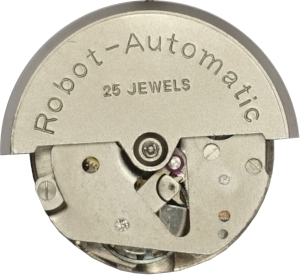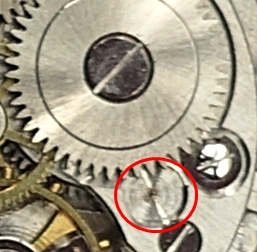Collectors of vintage wristwatches occasionally come across movements marked Robot-Automatic. The interesting thing about this is that an automatic module is mounted on base movements from different manufacturers.

So far I have been able to find the Robot-Automatic on movements from Guba, AHO, AHS, INTEX and Uwersi. All German manufacturers without exception.
But who was the manufacturer of the automatic module?
The design is presumably based on the American patent US2810255 by Gérard A. Langel, a French inventor who also developed the well-known Ultra Superautomatic. Those interested can find detailed information about Gérard A. Langel and the Superautomatic here: Ultra – Watches and Movements from France. The aforementioned patent with the title Self-Winding Watch Movement was applied for as early as 1953, but was only granted in 1957!

At the time, Langel was working for the United States Time Corporation, which had many names throughout its history, including Ingersoll, Waterbury and Timex. It is therefore possible that this company manufactured and sold the Robot Automatic modules.
Some sources also suspect AHO as the manufacturer, but I have not yet been able to find any real proof of this. However, there may have been a cooperation between AHO and the US Time Corporation or Langel. The design of the automatic module is much more similar to the typical movements of Ingersoll or Timex than to AHO. In any case, the Robot-Automatic was probably only used in Germany.
Let’s take a look at how the Robot-Automatic works.

The side view clearly shows that the automatic module significantly increases the height of the movement. Including the rotor, it is around 2.8 mm.

Not much had to be changed structurally to add the Robot Automatic to a hand-wound movement:
- Two or three holes for fastening the module, with spacer if necessary
- Recess close to the ratchet wheel, into which the driving gear of the automatic system can engage to tension the mainspring
- Replacement of the normal mainspring with a slipping mainspring

The Robot-Automatic module itself is very simply constructed. First, let’s take a look at the top of the module and the back of the rotor:

There is an eccentric ring on the back of the rotor, along the outside of which two ruby rollers of the automatic module run. There are two levers on the ruby rollers, at the end of which small clicks on the back of the module engage with the driving gear and turn it:

The clicks ensure that the driving gear always turns in the same direction, regardless of the direction in which the rotor is turning. The driving gear, in turn, engages with the ratchet wheel of the base movement and thus winds up the mainspring.
In other words, this is an eccentric changer that winds on both directions!
Its mode of operation is very similar to the well-known Pellaton winding system from IWC (IWC Pellaton Automatic Winding System Model).
In most automatic designs, there are two reduction wheels between the rotor and the drive wheel to reduce the rotational speed of the ratchet wheel and increase the torque. The Robot-Automatic’s winding mechanism was therefore probably rather stiff and required a lot of movement.
It is also interesting to note that the module has no removable parts, as these are all riveted to the plate. In other words, a classic disposable module that was completely replaced in the event of a defect.
The rotor of the Robot-Automatic often seems to be marked with 25 jewels. The module itself only has two of them, namely the ruby rollers. In many cases, it is doubtful that the base movement has 23 jewels, as hand-wound movements usually have 15 or 17 of them. The Guba 1200 AUT shown here has 21 jewels, including four non-functional cap jewels, i.e. 23 with automatic. “21 Jewels” is also marked on the base movement, but the 21 is hidden under the automatic module.
